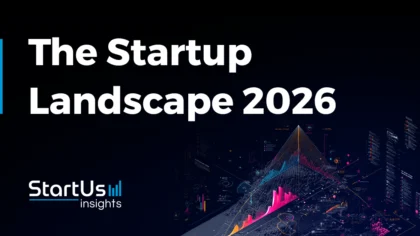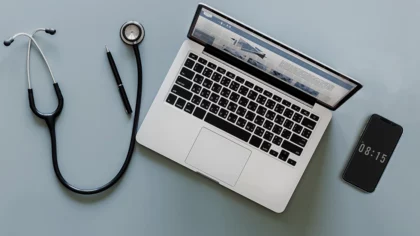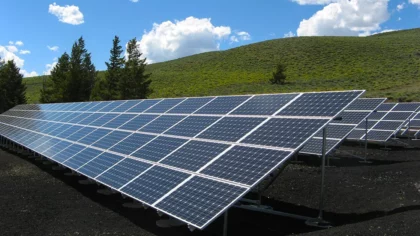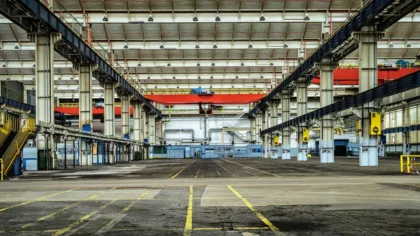Accelerate Productivity in 2025
Reignite Growth Despite the Global Slowdown
The Internet of Things (IoT) improves operational workflows and enhances efficiency and responsiveness by leveraging interconnected devices and real-time data analytics. As IoT technology evolves, it integrates closely with Artificial Intelligence and edge computing to advance automation, real-time decision-making, and innovative applications across industries. For instance, in smart manufacturing, IoT-enabled sensors embedded in machinery capture performance metrics, such as temperature, vibration, and energy usage, feeding this data into advanced analytics platforms.
This continuous monitoring enables predictive maintenance by identifying potential failures before they disrupt production, thus reducing downtime, and minimizing maintenance costs. Further, in healthcare, IoT devices, such as wearable biosensors and connected medical equipment, monitor patients continuously. These devices transmit health data to cloud-based platforms for real-time tracking and enable automated alerts for timely medical interventions, ultimately improving patient outcomes and reducing the burden on healthcare providers.
Stakeholders should adapt to these innovations to maintain their competitive advantages. That’s why we created this in-depth report exploring the impact of IoT technology and the strategic shifts required for businesses to grow in the new digital economy.
Why should you read this report?
- Gain in-depth insights into the top 10 technologies impacting IoT
- Learn about three practical use cases for each technology
- Meet 10 innovative startups advancing these technologies
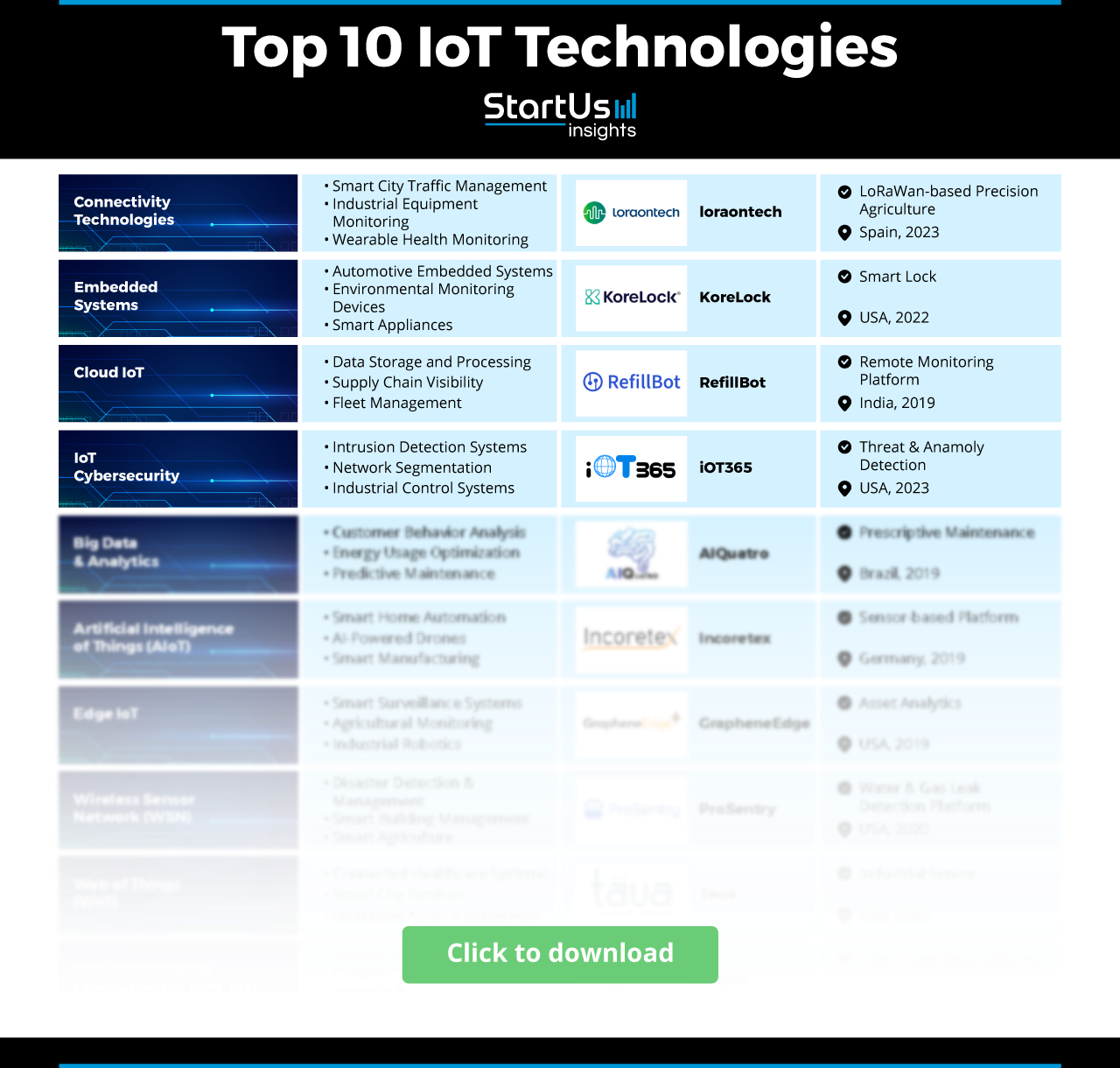
Key Takeaways
- Connectivity Technologies
- Use Cases:
- Smart City Traffic Management
- Industrial Equipment Monitoring
- Wearable Health Monitoring
- Startup to Watch: loraontech
- Use Cases:
- Embedded Systems
- Use Cases:
- Automotive Embedded Systems
- Environmental Monitoring Devices
- Smart Appliances
- Startup to Watch: KoreLock
- Use Cases:
- Cloud IoT
- Use Cases:
- Data Storage and Processing
- Supply Chain Visibility
- Fleet Management
- Startup to Watch: RefillBot
- Use Cases:
- IoT Cybersecurity
- Use Cases:
- Intrusion Detection Systems
- Network Segmentation
- Industrial Control Systems
- Startup to Watch: iOT365
- Use Cases:
- Big Data and Analytics
- Use Cases:
- Customer Behavior Analysis
- Energy Usage Optimization
- Predictive Maintenance
- Startup to Watch: AIQuatro
- Use Cases:
- Artificial Intelligence of Things (AIoT)
- Use Cases:
- Smart Home Automation
- AI-Powered Drones
- Smart Manufacturing
- Startup to Watch: Incoretex
- Use Cases:
- Edge IoT
- Use Cases:
- Smart Surveillance Systems
- Agricultural Monitoring
- Industrial Robotics
- Startup to Watch: GrapheneEdge
- Use Cases:
- Wireless Sensor Network (WSN)
- Use Cases:
- Disaster Detection and Management
- Smart Building Management
- Smart Agriculture
- Startup to Watch: ProSentry
- Use Cases:
- Web of Things (WoT)
- Use Cases:
- Connected Healthcare Systems
- Smart City Services
- Enterprise Asset Management
- Startup to Watch: Taua
- Use Cases:
- High Performance Computing IoT (HPC IoT)
- Use Cases:
- Climate Modeling
- Complex Manufacturing Simulation
- Space Exploration Data Analysis
- Startup to Watch: Pixora
- Use Cases:
What You Need to Know About the IoT
What is the Internet of Things tech?
Internet of Things technology refers to a network of interconnected devices that communicate and exchange data through the internet. These devices range from everyday household items, like smart thermostats and refrigerators, to industrial machinery and infrastructure systems. Each device integrates with sensors, software, and other technologies that enable it to collect and transmit data for remote monitoring and control.
IoT technology relies on various protocols and standards to ensure seamless connectivity and interoperability between devices. Common communication protocols include message queuing telemetry transport (MQTT) and constrained application protocol (CoAP). The integration of artificial intelligence and machine learning (ML) enhances IoT applications by enabling data analysis and real-time decision-making. This improves efficiency and productivity across various sectors, such as manufacturing, healthcare, and smart cities.
What is the future of Internet of Things innovation?
The future of IoT technology includes advancements for increasing connectivity and data processing capabilities. For instance, 5G networks enhance the speed and reliability of IoT communications to enable real-time data exchange and build more complex applications. With edge computing, data processing occurs closer to the source to reduce latency and improve response times for applications, such as autonomous vehicles and remote healthcare monitoring. As organizations prioritize data security and privacy, future IoT systems will incorporate advanced cybersecurity measures to protect sensitive information.
Moreover, the integration of blockchain technology offers solutions for enhancing data integrity and traceability across IoT networks. Plus, the adoption of IoT in sectors like agriculture, logistics, and energy, improves resource optimization and sustainability. On the other hand, the use of IoT applications also raises challenges, particularly in managing the vast amount of data generated. However, effective data analytics tools and frameworks will further improve to extract valuable insights from this data.
Where is this Data from?
StartUs Insights provides actionable insights through its comprehensive Discovery Platform, which covers 4.7+ million startups, scaleups, and tech companies globally, as well as 20K+ emerging technologies & trends. The platform excels in startup and technology scouting, trend intelligence, and patent searches, offering a detailed view of the innovation landscape. For this report, we analyzed technologies within specific industries using the trend intelligence feature. During this research, we identified patterns and trends, pinpointing relevant use cases and the startups developing solutions for each. More capabilities and details are available at StartUs Insights Discovery Platform.
10 Emerging Technologies Impacting the Future of IoT [2025 & Beyond]
1. Connectivity Technologies
Connectivity technologies enable communication between devices, sensors, and cloud platforms. Various protocols and methods support this connectivity, including Wi-Fi, Bluetooth, cellular networks, Zigbee, and long-range wide area networks (LoRaWAN). Each technology improves specific applications, such as low-power, long-range communication, or high-speed data transfer. For instance, cellular networks provide reliable wide-area coverage, while Zigbee creates low-power mesh networks for home automation. Such connectivity enhances the functionality and scalability of IoT solutions to ensure efficient data sharing and real-time monitoring across industries, from smart cities to industrial applications.
3 Practical Use Cases of Connectivity Technologies:
- Smart City Traffic Management: Connected devices leverage sensors, cameras, and real-time data analytics to enhance urban mobility. They monitor traffic patterns and adjust traffic signals for smoother traffic flow and reduced congestion. This improves commuter experiences and enhances road safety by allowing for rapid responses to accidents and traffic disruptions.
- Industrial Equipment Monitoring: Connectivity allows for real-time data collection from sensors attached to equipment, enabling monitoring machinery performance across various sectors. As a result, predictive maintenance strategies are developed to identify potential failures before they happen. Thus, connectivity minimizes downtime and optimizes operational efficiency.
- Wearable Health Monitoring: Wearable devices collect and transmit health data, such as heart rate, sleep patterns, and activity levels, to healthcare professionals. This real-time data transmission enables continuous health assessments for timely interventions if abnormalities are detected. Thanks to remote monitoring capabilites, these devices enhance preventive care and offer personalized treatments.
Startup to Watch: loraontech
Spanish startup loraontech optimizes agriculture with its LoRaWAN IoT system. The system utilizes sensors to monitor and control soil, environmental, and leaf condition parameters in real-time. This enables data-driven decisions making, enhancing crop performance. Features include detecting diseases, issuing frost warnings, and optimizing irrigation based on soil conditions. Additionally, the system enables precise crop nutrient management to reduce resource consumption and increase productivity.
2. Embedded Systems
Embedded systems enable devices to process and exchange data within a connected ecosystem. These systems integrate technologies, such as microcontrollers, sensors, and actuators, for efficient data collection and real-time decision-making. Specific connectivity options like Wi-Fi, bluetooth, ZigBee, and cellular networks enhance embedded systems for improving communication across devices and the cloud. Further, the integration of cloud computing and data analytics leverages vast amounts of information to enable smarter operations and enhanced user experiences.
3 Practical Use Cases of Embedded Systems:
- Automotive Embedded Systems: These use a network of sensors and software to enhance vehicle functionality via real-time data processing and communication. The systems enable applications such as advanced driver assistance (ADAS), vehicle-to-everything (V2X) communication, and predictive maintenance allowing vehicles to respond proactively to environmental conditions and potential hazards.
- Environmental Monitoring Devices: Embedded systems in these devices utilize sensors to collect data on air and water quality, temperature, and other ecological factors. They transmit real-time information to centralized systems for immediate analysis and response to environmental changes. Such monitoring improves regulatory compliance and enhances decision-making processes in environmental management.
- Smart Appliances: Smart applicances incorporate embedded systems to provide real-time data and remote control capabilities, enhancing convenience and energy efficiency. These devices connect to the internet to provide features such as automated energy management and remote diagnostics.
Startup to Watch: KoreLock
US-based startup KoreLock offers a patented IoT technology platform that includes firmware, printed circuit board assemblies (PCBAs), mobile applications, and cloud infrastructure for remote monitoring and control. It converts traditional electronic locks into Wi-Fi-enabled smart locks for easy integration and enhanced functionality. The platform’s features include local management through bluetooth, credential flexibility to support access methods such as PIN codes and mobile credentials, and a patented Wi-Fi technology that extends battery life by operating on existing networks. This way, the company enhances safety and efficiency in access control systems.
3. Cloud IoT
The Cloud IoT framework provides device connectivity, real-time data processing, and scalable management of IoT-generated data. It leverages edge computing for low-latency analytics for applications like autonomous systems and industrial automation. Advanced security protocols, such as end-to-end encryption and access control, safeguard data, while machine learning (ML) models provide predictive analytics and automation. The integration of cloud services enables remote device management and insights for driving intelligent automation, proactive maintenance, and efficiency across sectors like manufacturing, logistics, and healthcare.
3 Practical Use Cases of Cloud IoT:
- Data Storage and Processing: Cloud IoT enables data storage and processing by providing solutions that aggregate the data generated by IoT devices. This analyzes and derives insights from their data without extensive on-premises infrastructure. As a result, it enhances data accessibility and improves decision-making processes.
- Supply Chain Visibility: Integrating Cloud IoT into supply chain operations enhances visibility by tracking assets and shipments in real-time through interconnected devices and platforms. This connectivity provides insights into inventory levels, shipment statuses, and delivery timelines. Moreover, it reduces operational costs, minimizes delays, and improves customer satisfaction.
- Fleet Management: In logistics, Cloud IoT collects and analyzes vehicle data through connected sensors and devices. Thus, it allows fleet operators to monitor vehicle performance, optimize routes, and implement predictive maintenance strategies. This enhances operational efficiency, reduces fuel costs, and improves overall safety.
Startup to Watch: RefillBot
Indian startup RefillBot builds an IoT platform that connects devices to the internet for remote monitoring and management. The platform integrates a RefillBot board into existing electronic devices or consumer appliances to monitor and control their equipment through a unified cloud dashboard. Features include connecting multiple sensors, probes, or control panel data from supervisory control and data acquisition: (SCADA)/programmable logic controller (PLC) systems while supporting communication methods such as the global system for mobile communications (GSM), Wi-Fi, and bluetooth for cloud connectivity. Thus, the platform makes devices smarter and enhances operational efficiency through integration and real-time data insights.
4. Cybersecurity
Cybersecurity ensures the integrity and safety of interconnected devices and systems. The technology employs advanced encryption protocols such as transport layer security (TLS) 1.3 and advanced encryption standard (AES-256), along with public key infrastructure (PKI) for secure data transmission and device authentication. Network-based intrusion detection systems (IDS) monitor traffic for anomalies, while machine learning-powered analytics detect irregularities and automate threat responses. Blockchain adds an extra layer by providing decentralized, tamper-proof data exchange and device verification to enhance overall security and privacy in IoT ecosystems.
3 Practical Use Cases of Cybersecurity:
- Intrusion Detection Systems: Cybersecurity enhances intrusion detection systems (IDS) by utilizing algorithms to monitor network traffic for anomalies and unauthorized access attempts. This continuous surveillance detects threats in real-time to reduce the impact of cyberattacks. The implementation of effective IDS enhances network security and enables faster response times to threats to protect sensitive data and maintain the integrity of connected systems.
- Network Segmentation: Divides networks into smaller, manageable segments to limit the potential attack surface. This strategy protects the spread of attack to the entire network from one segment. Isolation of systems improves their security posture, enables them to contain breaches more effectively, and reduces the overall risk of data loss or system failure.
- Industrial Control Systems (ICS): This includes deploying machine learning techniques that analyze traffic patterns to identify potential attacks on operational technology environments. Enhancing the security of ICS minimizes downtime and maintains operational efficiency to ensure the safety and reliability of industrial processes.
Startup to Watch: iOT365
US-based startup iOT365 improves operational technology security by providing an AI-driven Software-as-a-Service (SaaS) platform. The startup integrates a patented agentless intrusion detection system (IDS) and security information and event management (SIEM) platform that streamlines the deployment process with its sensors and virtual machine. It filters and sorts operational technology (OT), ICS, and IoT traffic to allow only relevant data to reach the centralized collector for analysis. Thus, the platform improves scalability through a distributed architecture, enhanced security via unidirectional diodes, and advanced threat detection powered by machine learning algorithms.
5. Big Data & Analytics
Big data and analytics leverage advanced technologies like machine learning, artificial intelligence, and distributed computing frameworks to process and analyze complex data sets in real-time. Data streaming and analytics frameworks enable the continuous flow and examination of information from IoT sensors and devices by offering tools to derive insights. Additionally, cloud computing platforms provide scalable storage and processing power to enhance the capabilities of big data analytics for IoT applications. Such data analysis optimizes operations and improves decision-making.
3 Practical Use Cases of Big Data & Analytics:
- Customer Behavior Analysis: Big data and analytics gather and analyze large volumes of customer data from IoT devices to identify patterns and trends in consumer behavior. This allows for the creation of targeted marketing strategies and personalized services that align with customer preferences. This leads to enhanced customer satisfaction and loyalty, as companies provide tailored experiences that meet individual needs while maximizing engagement and retention.
- Energy Usage Optimization: Advanced analytics process real-time data from smart meters and IoT devices to monitor energy consumption patterns. Thus, it identifies inefficiencies and suggests strategies for energy conservation. As a result, it reduces energy costs and optimizes resource allocation.
- Predictive Maintenance: Leveraging big data & analytics for predictive maintenance involves continuously monitoring equipment and analyzing data from IoT sensors to forecast potential failures and schedule maintenance proactively. This reduces downtime and maintenance costs while enhancing overall operational efficiency to maintain productivity and extend the lifespan of heavy assets.
Startup to Watch: AIQuatro
Brazilian startup AIQuatro develops an IoT platform that offers maintenance solutions through advanced monitoring and data analytics. The startup connects sensors and devices to a unified cloud dashboard for real-time data collection and remote management of operations. With features such as plug-and-play installation, the platform simplifies connectivity and reduces deployment time. Further, the platform offers customizable insights by providing access to detailed AI-driven analytics, enhancing operational efficiency by proactively managing maintenance.
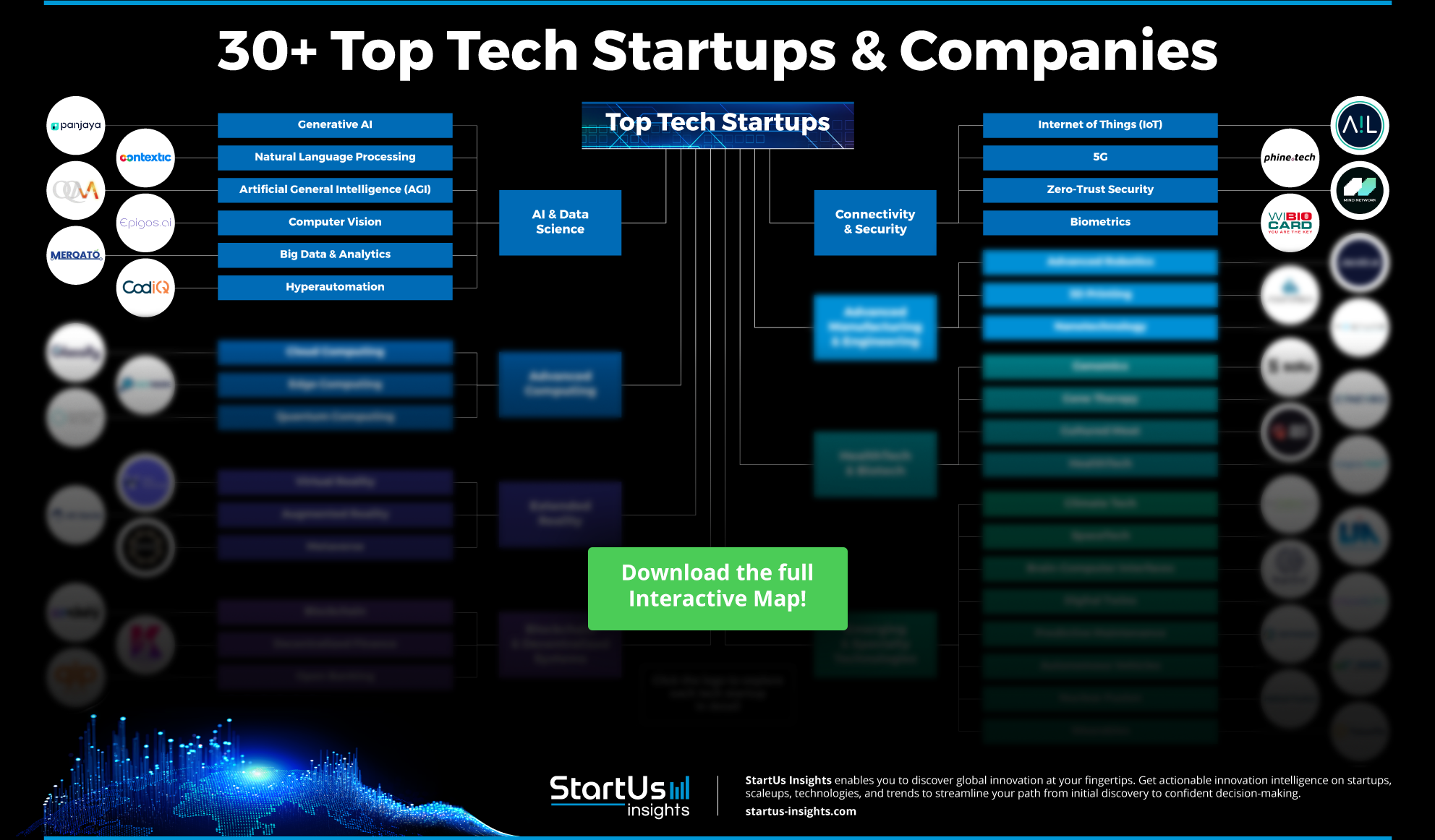
6. Artificial Intelligence of Things (AIoT)
AIoT integrates AI with IoT to create intelligent systems for processing and analyzing data in real-time. It utilizes edge computing, which allows data processing closer to the source to reduce latency and improve response times. Additionally, machine learning algorithms and AI chipsets installed in IoT devices can make autonomous decisions based on vast datasets collected from sensors. Cloud computing platforms further enhance AIoT by providing scalable resources for data storage and complex analysis, while protocols like MQTT and APIs provide communication between devices and applications.
3 Practical Use Cases of AIoT:
- Smart Home Automation: Smart homes integrate AI algorithms with IoT devices to create responsive and intelligent living environments. This, for instance, optimizes energy consumption based on user behavior by adjusting heating and lighting when residents are home or away. As a result, it improves energy efficiency, enhances comfort through personalized settings, and increases convenience as devices adapt to the residents’ routines.
- AI-Powered Drones: AIoT enhances operational efficiency by equipping drones with real-time data processing capabilities and autonomous navigation systems. These drones analyze environmental data to optimize flight paths, conduct aerial inspections, and monitor agricultural conditions effectively. Thus, their integration improves productivity and safety for industries such as agriculture and logistics to perform tasks with higher accuracy and reduced labor costs.
- Smart Manufacturing: Smart manufacturing utilizes AI-driven analytics to monitor machinery performance and predict maintenance needs. This real-time monitoring detects anomalies and schedules repairs before equipment failures occur. The implementation of AIoT in manufacturing reduces downtime, increases operational efficiency, and enhances quality control to improve productivity.
Startup to Watch: Incoretex
German startup Incoretex builds a sensor technology for IoT infrastructure and AI-based solutions. The company’s products enable connectivity and data analysis by integrating ultra-thin, flexible sensors into existing devices to gather data and enhance functionality. Features include an end-to-end connectivity infrastructure for bringing products online, remote access and control capabilities, and over-the-air updates for device management. Additionally, Incoretex offers AI-driven analytics that provide insights and automate processes.
7. Edge IoT
Edge IoT brings computation and data processing closer to the source of data generation. It leverages edge computing platforms, which enable devices to perform real-time data analysis without relying on centralized cloud servers. The integration of AI and machine learning directly into edge devices enhances the responsiveness and efficiency of their IoT systems. Further, 5G connectivity improves the performance of edge IoT to provide faster data transmission and reduce latency. This localized processing allows for intelligent decision-making on-site for applications that demand immediate responses to improve operational efficiency and better resource management.
3 Practical Use Cases of Edge IoT:
- Smart Surveillance Systems: Edge IoT processes video data locally through edge devices, enabling real-time analysis and immediate threat detection. It allows security personnel to respond swiftly to incidents and reduce the time between detection and action. As a result, such systems improve security measures, lower bandwidth costs due to reduced data transmission to centralized servers, and operate effectively in bandwidth-constrained environments.
- Agricultural Monitoring: In agriculture, edge IoT analyzes environmental data collected from sensors located directly in the fields in real-time. This setup enables farmers to monitor soil moisture, weather conditions, and crop health for timely interventions based on current data rather than relying on cloud processing. As a result, edge IoT increases resource efficiency, such as optimizing water usage and reducing fertilizer waste for enhancing crop yield and sustainability in farming practices.
- Industrial Robotics: Edge IoT allows machines to process data locally for performing tasks autonomously while minimizing latency. In manufacturing settings, this integration enables robots to react to changes in their environment instantly and improve their operational efficiency. Further, it enhances productivity, reduces downtime, and maintains consistent quality control to continuously monitor the robots’ performance and adjust operations in real-time.
Startup to Watch: GrapheneEdge
US-based startup GrapheneEdge develops an operational management platform for the energy industry. It provides connectivity and data exchange among distributed energy resources (DERs) to monitor and control IoT and industrial internet of things (IIoT) assets in real-time. Features include a distributed architecture that enhances scalability, over-the-air updates for efficient management, and agentless data aggregation through its proprietary technology. Additionally, Graphene Edge offers real-time analytics and automated decision-making to improve operational efficiency and security.
8. Wireless Sensor Network (WSN)
Wireless Sensor Networks provide the infrastructure necessary for real-time monitoring and data collection. It utilizes specific components such as sensor nodes, gateways, and communication protocols like ZigBee and LoRaWAN to offer low-power, long-range wireless communication. The architecture of WSNs allows for efficient data aggregation and transmission for enhanced connectivity and scalability in IoT systems.
3 Practical Use Cases of WSN:
- Disaster Detection and Management: WSNs deploy sensors that monitor environmental parameters such as temperature, humidity, and seismic activity in real-time. This enables rapid data collection and analysis to offer early warnings for natural disasters like floods, earthquakes, or fires. As a result, response times are reduced while preparation times increase, minimizing lost lives and property damage during emergencies.
- Smart Building Management: In smart building management, WSNs enable the integration of various environmental sensors to monitor conditions such as temperature, occupancy, and air quality throughout a facility. This networked approach allows building managers to optimize energy use and enhance occupant comfort by adjusting systems in real-time based on current conditions. Consequently, businesses experience reduced operational costs and improved sustainability through efficient resource management and lower energy consumption
- Smart Agriculture: WSNs significantly enhance smart agriculture by providing farmers with the ability to monitor soil conditions, crop health, and weather patterns through a network of deployed sensors. These sensors deliver real-time data, enabling precise irrigation, nutrient delivery, and pest control tailored to specific crop needs. The application leads to increased crop yields, reduced resource waste, and improved overall farm management efficiency, contributing to more sustainable agricultural practices.
Startup to Watch: ProSentry
US-based startup ProSentry develops a smart building monitoring platform that detects water and gas leaks, as well as mechanical and environmental issues. It integrates multiple wireless sensor technologies to customize the monitoring systems and receive real-time alerts. The company offers a setup process for the platform that includes deploying sensors and setting up access to a personalized dashboard that consolidates all monitoring data. Additionally, it offers 24/7 monitoring capabilities, immediate notifications via text messages or app alerts, and integration with existing systems to reduce risks and operational costs.
9. Web of Things (WoT)
The WoT utilizes standardized web technologies, such as hypertext transfer protocol (HTTP), RESTful APIs, and javascript object notation (JSON), to communicate between IoT devices and applications. By creating a common framework for device interaction, WoT enables devices to share data and collaborate. Essential components of WoT include the Thing Description (TD), which provides machine-readable metadata for connected devices, and binding templates that ensure compatibility across different protocols.
3 Practical Use Cases of WoT:
- Connected Healthcare Systems: WoT enhances connected healthcare systems by enabling integration and communication between medical devices, sensors, and applications through standardized web protocols. This connectivity allows for real-time monitoring of patient health data for timely interventions and remote consultations. As a result, healthcare providers improve patient outcomes and optimize resource allocation to enhance efficiency in the healthcare industry.
- Smart City Services: In Smart Cities, the WoT integrates urban management systems through interconnected sensors and devices that communicate over the internet. This connectivity enables cities to monitor traffic, manage public safety, and optimize resource usage to create a more responsive urban environment. Benefits include improved citizen engagement, public services, and cost savings through resource management.
- Enterprise Asset Management: The technology connects devices and systems that track and manage assets in real-time. This integration provides a view of the assets for monitoring, predictive maintenance, and resource optimization. Thus, it reduces operational costs, improves asset utilization, and enhances decision-making capabilities through data-driven insights.
Startup to Watch: Taua
Italian startup Taua develops advanced IoT sensor technology for industrial and large-scale applications, called Tauanito. The company’s sensor integrates multiple functionalities, including GPS, data measurement, and collection, utilizing E-SIM technology for data transmission. Further, it employs a web-based application to access real-time data visualizations and reports from any device to enhance operational oversight. Features include ultra-high-resolution capabilities, modular design for flexible sensor integration, and blockchain encryption for data security and legal compliance. Thus, the company simplifies monitoring processes, provides insights, and enhances the efficiency of asset management.
10. High Performance Computing IoT (HPC IoT)
HPC IoT integrates advanced computing capabilities with IoT to analyze vast datasets generated by connected devices. This integration utilizes technologies such as high-performance processors, parallel computing architectures, and cloud-based platforms that support extensive data processing. Further, it uses multi-core CPUs and GPUs to increase computational capabilities to enable rapid simulations, deep analytics, and real-time processing of complex data. Additionally, distributed data processing frameworks enhance the efficiency of large-scale data management.
3 Practical Use Cases of HPC IoT:
- Climate Modeling: HPC IoT enhances climate modeling by utilizing advanced computational power to process climate data and simulate complex atmospheric processes. This creates high-resolution models that improve the accuracy of weather predictions and climate change projections. Also, it allows for better preparedness for climate-related impacts and enables proactive decision-making that minimizes risks associated with severe weather events.
- Complex Manufacturing Simulation: HPC can run detailed simulations of production processes, materials behavior, and system performance. It integrates IoT data into these simulations to offer insights into efficiency improvements and potential bottlenecks. This enhances production planning, reduces costs, and improves product quality while optimizing the manufacturing processes based on real-time data.
- Space Exploration Data Analysis: HPC provides the necessary computational resources to analyze large volumes of data from missions and experiments conducted in space. This analysis models planetary systems, evaluates spacecraft performance, and simulates conditions for upcoming missions. It also enhances discovery and innovation in space science, as enhanced data analysis provides more informed mission designs and successful outcomes.
Startup to Watch: Pixora
Italian startup Pixora offers PIXORA EDGE, a set of hardware-software tools designed for deployment across various IT infrastructures that support container technology. The company’s IoT and AI platform operates as a SaaS solution on cloud services or on-premise to monitor and control industrial machinery. Features include machine monitoring that minimizes downtime, predictive maintenance with an AI engine to prevent failures, and a device manager that simplifies remote configuration and monitoring. Additionally, PIXORA EDGE enhances production processes by offering insights into efficiency, tracking work orders, and enabling customizable applications for operational needs.
Leverage Emerging IoT Technologies
Act now on the emerging IoT technologies transforming your industry. With StartUs Insights, you swiftly discover hidden gems among over 4.7 million startups, scaleups, and tech companies, supported by 20K+trends and technologies. Our AI-powered search and real-time database ensure exclusive access to innovative solutions, making the global innovation landscape easy to navigate.
Trusted by industry leaders like Samsung, Nestlé, and Magna, we provide unmatched data, a 360-degree industry view, and data-driven intelligence for confident strategic decisions. For instance, here is what Carlos Cruz, the Innovation Manager at ITURRI Group has to say about our platform, “The depth of information that StartUs Insights delivers is exactly what we need to identify relevant startups, technologies, and innovation trends. It saves us a lot of time and provides data we can’t find elsewhere“.
Leverage our innovation services to optimize costs, streamline operations, and stay ahead of the curve. Get in touch today to explore how our comprehensive innovation intelligence can drive your success.
Discover All IoT Technologies & Startups!
![Future of IoT: 10 Emerging Technologies [2025 & Beyond]](https://www.startus-insights.com/wp-content/uploads/2024/10/Future-of-IoT-SharedImg-StartUs-Insights-noresize-420x236.webp)
